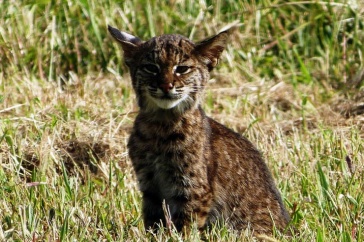UNH Scientists Find People May Be Stressing Out N.H.’s Bobcats

According to New Hampshire Fish and Game and UNH researchers, New Hampshire has approximately 1,400 bobcats.
DURHAM, N.H.—The bobcat, New Hampshire’s official state wildcat and a critical contributor to the sustainability of the state's forest ecosystem, may be being stressed out by human activity in residential and agricultural areas, according to scientists with the New Hampshire Agricultural Experiment Station at the University of New Hampshire.
Researchers have found that hair samples of bobcats living closer to residential and agricultural areas have higher cortisol levels. All mammals—including humans—have a stress response where, when faced with difficult and threatening situations, the hormone cortisol is released. Increased cortisol in hair samples often is a marker of higher stress levels because the more of the hormone circulating in the bloodstream, the more that will end up in your hair.
“Under normal conditions, cortisol helps our bodies regulate energy and gives us the resources needed to deal with the stressful situation. This is a good thing for our bodies—we deal with the situation then return to normal. However, chronically high cortisol levels can worsen individual bobcats’ health and lower reproduction rates of populations,” said wildlife ecologist Rory Carroll, assistant professor of biology at Southern Arkansas University. Carroll conducted the research with Marian K. Litvaitis, professor emerita of natural resources and the environment, and Thomas Foxall, professor of biological sciences, as part of his doctoral research at UNH.
They also found that bobcat cortisol levels differ in key ways. Males and females had different responses to the landscape, but in general a greater proportion of residential and agricultural land uses was associated with higher cortisol levels. Larger bobcats had lower cortisol levels. Cortisol in all bobcats was lower in the spring than in the fall. Finally, below-average temperatures in the fall related to lower cortisol levels.
According to New Hampshire Fish and Game and UNH researchers, New Hampshire has approximately 1,400 bobcats. Small predators such as bobcats and coyotes are the top “apex” predators in the region. As such, they have a large impact on the state's forest ecosystems, helping sustain balanced wildlife communities of smaller mammals such as rodents, rabbits, and groundhogs that can carry diseases and disrupt production on commercial farms and backyard gardens.
This is the latest research, published in the Journal of Wildlife Management, from this team of researchers, who has been studying bobcat population dynamics for years using several methods, including studies of diet and genetics. “Populations are always changing, and we want to understand what has caused some pretty dramatic rises and falls over the decades. Bobcats are currently abundant across the region despite a huge human influence on the landscape. Knowledge on how they are learning to live alongside humans will ultimately help us be better and more responsible neighbors of our wildlife species and target conservation efforts in critical areas to sustain healthy populations of bobcats,” Carroll said.
This material is based upon work supported by the NH Agricultural Experiment Station, through joint funding of the National Institute of Food and Agriculture, U.S. Department of Agriculture, under award number 1009906, and the state of New Hampshire. It also was supported by the National Science Foundation Graduate Research Fellowship, under award number 147766, and the Southern Arkansas University Foundation. NH Fish and Game, VT Fish and Wildlife, Squam Lake Natural Science Center, and Buttonwood Zoo made vital contributions to sampling efforts for this study.
Founded in 1887, the NH Agricultural Experiment Station at the UNH College of Life Sciences and Agriculture is UNH’s first research center and an elemental component of New Hampshire's land-grant university heritage and mission.
The University of New Hampshire is a flagship research university that inspires innovation and transforms lives in our state, nation, and world. More than 16,000 students from all 50 states and 71 countries engage with an award-winning faculty in top ranked programs in business, engineering, law, liberal arts, and the sciences across more than 200 programs of study. UNH’s research portfolio includes partnerships with NASA, NOAA, NSF, NIH, and USDA, receiving more than $100 million in competitive external funding every year to further explore and define the frontiers of land, sea, and space.
PHOTO AVAILABLE FOR DOWNLOAD
https://www.unh.edu/unhtoday/sites/default/files/media/images/bobcat.jpg
According to New Hampshire Fish and Game and UNH researchers, New Hampshire has approximately 1,400 bobcats.
Latest News
-
December 4, 2025
-
November 26, 2025
-
November 6, 2025
-
November 5, 2025
-
October 24, 2025














































